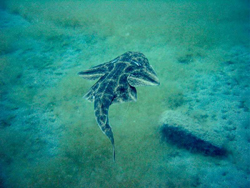Angel Shark

Common Name: Angel Shark
Scientific Name: Squatina Spp
Description
With its exceptionally flat body and large pectoral fins, the angel shark resembles a large ray more than a shark. Its skin is grey to reddish or greenish-brown, scattered with small white spots and blackish dots. Young angel sharks may also have white net-like markings and large, dark blotches, whilst adults are plainer. The dorsal fins have a dark leading edge and a pale trailing edge. It possesses simple, whisker-like projections near the nostrils, (nasal barbels), which are used to taste and feel. Large, round eyes with vertical slit pupils provide good all-round vision, enabling the angel shark to be an efficient ambush predator.
Diet
Angel sharks to eat small fishes, crustaceans, mackerel, croaker and molluscs.
Behaviour
Pacific angel shark are usually found lying partially buried on flat, sandy bottoms and in sand channels between rocky reefs during the day, but they may become active at night. Tagged specimens near Santa Catalina Island were found to move from a few feet to four nautical miles per night. However, individual sharks have been observed to remain in the same place with no apparent movement for up to 10 days.
Sexual maturity in both males and females occurs between 35 and 39 inches total length. Embryos present per female range between one and 11, with a mean of six pups produced annually from March to June. A 10-month gestation period was estimated for this species.
Habitat
Pacific shark, in difference to many species of sharks, is bottom dweller. It buries itself in sand or mud bottoms during the day, coming out to vigorously search for food at night. It is frequently found on the continental sill and littoral areas, and sometimes hang out near rocks, canyons and kelp forests. The adults are semi-nomadic, moving to new locations after expenditure days in a partial area. Although they normally occur alone, this species may be found in cumulative
Special Features or Habits
Several techniques have been utilized in an effort to age angel sharks, but to date aging this species has been unsuccessful. Researchers have observed that angel sharks are born with six to seven bands in their vertebral centra, but growth curves based on size and band counts were found to be atypical. Both centrum edge histology and size-frequency analyses have proven inconclusive. Sharks grown in the laboratory, along with field-tagged, tetracycline- injected returns, indicated no periodic basis for band deposition in the vertebrae, but indicated that calcified band deposition is more related to rapid somatic growth
Location or Region Found
The Pacific angel shark is reported to occur only in the eastern Pacific Ocean from southeastern Alaska to the Gulf of California and from Ecuador to Chile. A gap in distribution separating subpopulations of S. californica occurs between the equator and 20 North latitude. The southern population was earlier reported as a separate species, S.armata.
 Deep Sea Crabs
Deep Sea Crabs